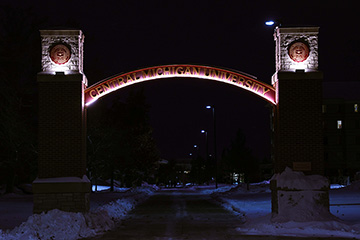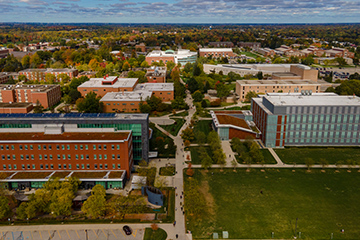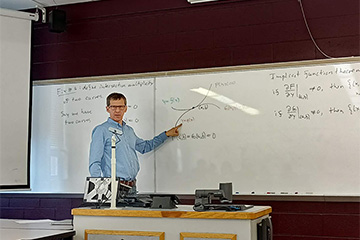New STEM certificate offers interdisciplinary experience
Program develops skills critical to workplace success, promotes diversity and equity
A new Central Michigan University certificate program provides real-world STEM experiences while helping students contribute their unique perspectives to solve problems through diversity of thought.
The first students of the Integration of Science, Technology, and Engineering program began their four-year, five-course journey this past spring in a pilot class.
The first year’s topic: working as a team.
An experience to reflect the real world
There’s no such thing as a working lab of one, said Dr. Wiline Pangle, InSciTE’s director. Labs today rely on a collaboration of scientists and engineers from across several disciplines.
InSciTE is structured to provide its students with that kind of experience. Students are placed into teams that include students from other majors to work on a problem.
“Real STEM career life requires that interdisciplinary approach,” Pangle said. The pioneer group of students have picked 11 different majors within the College of Science and Engineering.
This interdisciplinary structure brings as many points of view as possible to bear on a problem. Three biologists looking at the same problem will likely produce three similar solutions. A biologist, a physicist and an engineer looking at the same problem are more likely to produce three approaches.
Pangle, a biology department faculty member, has received support across the College of Science and Engineering. An advisory committee of more than a dozen faculty members from various disciplines helped her develop the program’s infrastructure.
While the problems are all drawn from real-world issues, a key component of InSciTE is tapping into the power of self-learning. Students focus on topics that interest them, which makes them active stakeholders in the project. So far, that’s resulted in students who are more productive and engaged in their work, she said.
The power of diversity in ideas
Diversity of backgrounds is as important as diversity in academic discipline when it comes to science and for the same reason, Pangle said. People from different backgrounds bring different perspectives to a problem, leading to different approaches to solving it.
InSciTE applies a broad definition of diversity, she said. They are broken down into racial groups, but there are also first-generation students and students from financially distressed backgrounds.
InSciTE’s teaching builds on ensuring equity, Pangle said. That means recognizing that some students start with additional challenges and then providing them with additional support.
For example, some students might require additional support to boost their confidence, Pangle said. It’s less important that they bring skills to the program than it is that they develop them while pursuing the certificate.
“What we care about is your potential to grow,” she said.
That meant applying a personal touch during the first group’s application process. Students were permitted to apply in whatever way they felt most comfortable, including video and audio clips, traditional written applications or even text messages.
The idea was to give students a chance to introduce themselves to determine whether they were a good fit, she said.
Guest speakers play a role, too, Pangle said. Successful professionals who can set a positive example and provide encouragement are regularly invited to share their stories.
Developing skills that are in demand
Employers aren’t just looking for people with technical skills, Pangle said. They’re also looking for people who can work in and lead a research team, collaborate and resolve conflicts.
Since January, the pioneer group has focused on developing these interpersonal skills.
While developing InSciTE’s framework, Pangle and Tracy Galarowicz, associate dean of the College of Science and Engineering, visited a similar program in Massachusetts, Pangle said. They were impressed at how well students who’d advanced through the program worked together.
So, they chose to focus on those skills first to give students four years to develop them, she said.
One skill is pitching ideas to other teams about which problems they should solve.
“In a research world, pitching is a critical skill,” Pangle said.
In the second year, InSciTE will focus on developing communications skills. While students will continue developing skills critical for collaboration, they’ll also work on persuasive communication and how to communicate effectively in a multi-disciplinary environment.
By the third and fourth years in the program, InSciTE students will pick research projects that appeal to them.
Pangle said she’s currently building partnerships with private companies, government agencies and non-governmental organizations for lasting support. Those partnerships could help the program develop future research projects.
Data to drive the program’s future
The first group consists of 33 students, but future classes are expected to include as many as 70 students. When the program is fully operational, up to 300 students could be enrolled in InSciTE across all four years.
Collecting information about the students’ experiences and progress through the program will provide Pangle and the advisory panel with a wealth of information that will help them strengthen InSciTE.
Data collection will include interviews with students, which will help identify places where the experiences of the students differ from InSciTE self-perception data. It will help faculty program leaders/advisory panel members find ways to better connect students to the desired teaching outcomes.




